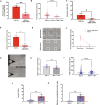A high-throughput microfabricated platform for rapid quantification of metastatic potential
- PMID: 39151003
- PMCID: PMC11328906
- DOI: 10.1126/sciadv.adk0015
A high-throughput microfabricated platform for rapid quantification of metastatic potential
Abstract
Assays that measure morphology, proliferation, motility, deformability, and migration are used to study the invasiveness of cancer cells. However, native invasive potential of cells may be hidden from these contextual metrics because they depend on culture conditions. We created a micropatterned chip that mimics the native environmental conditions, quantifies the invasive potential of tumor cells, and improves our understanding of the malignancy signatures. Unlike conventional assays, which rely on indirect measurements of metastatic potential, our method uses three-dimensional microchannels to measure the basal native invasiveness without chemoattractants or microfluidics. No change in cell death or proliferation is observed on our chips. Using six cancer cell lines, we show that our system is more sensitive than other motility-based assays, measures of nuclear deformability, or cell morphometrics. In addition to quantifying metastatic potential, our platform can distinguish between motility and invasiveness, help study molecular mechanisms of invasion, and screen for targeted therapeutics.
Figures





References
-
- Chaffer C. L., Weinberg R. A., A perspective on cancer cell metastasis. Science 331, 1559–1564 (2011). - PubMed
-
- Kortam S., Merkher Y., Kramer A., Metanes I., Ad-el D., Krausz J., Har-Shai Y., Weihs D., Rapid, quantitative prediction of tumor invasiveness in non-melanoma skin cancers using mechanobiology-based assay. Biomech. Model. Mechanobiol. 20, 1767–1774 (2021). - PubMed
-
- Merkher Y., Horesh Y., Abramov Z., Shleifer G., Ben-Ishay O., Kluger Y., Weihs D., Rapid cancer diagnosis and early prognosis of metastatic risk based on mechanical invasiveness of sampled cells. Ann. Biomed. Eng. 48, 2846–2858 (2020). - PubMed
-
- Hu J., Zhou Y., Obayemi J. D., Du J., Soboyejo W. O., An investigation of the viscoelastic properties and the actin cytoskeletal structure of triple negative breast cancer cells. J. Mech. Behav. Biomed. Mater. 86, 1–13 (2018). - PubMed
Publication types
MeSH terms
Grants and funding
LinkOut - more resources
Full Text Sources

